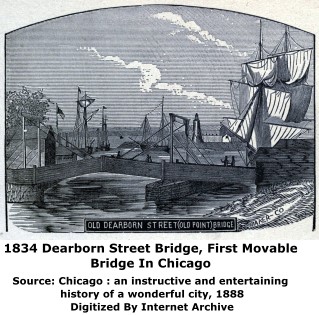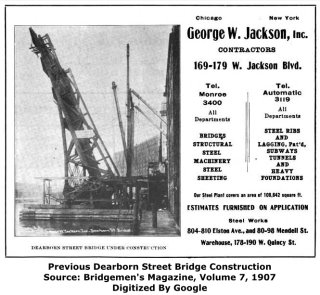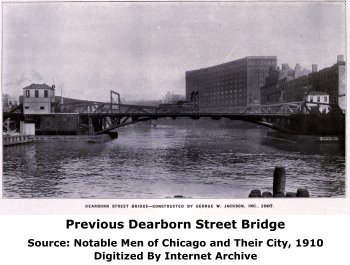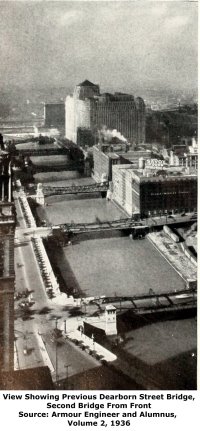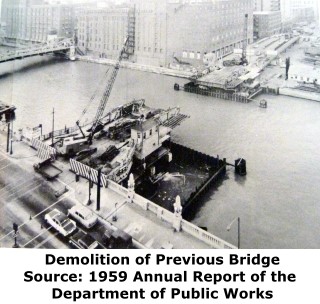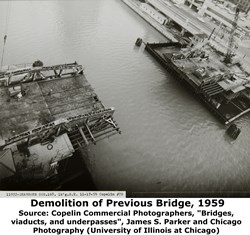We Recommend:
Bach Steel - Experts at historic truss bridge restoration.
BridgeHunter.com Phase 1 is released to the public! - Visit Now
Dearborn Street Bridge
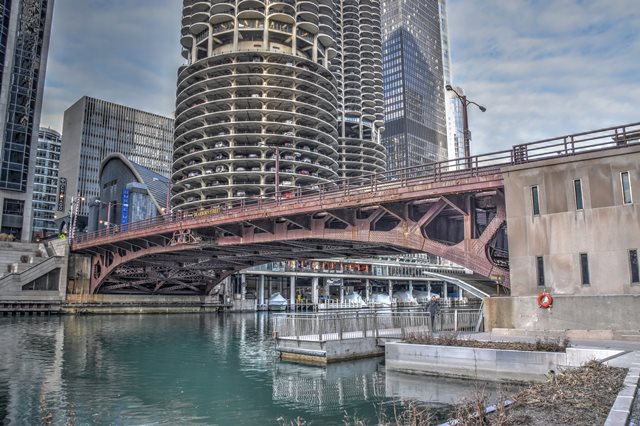
Primary Photographer(s): Nathan Holth
Bridge Documented: August 12, 2006 - October 14, 2021
Chicago: Cook County, Illinois: United States
Metal Rivet-Connected Pratt Railing Height Truss, Movable: Double Leaf Bascule (Fixed Trunnion) and Approach Spans: Metal Stringer (Multi-Beam), Fixed
1963 By Builder/Contractor: Overland Construction Company of Chicago, Illinois and Engineer/Design: City of Chicago
2006
235.0 Feet (71.6 Meters)
341.0 Feet (103.9 Meters)
56 Feet (17.07 Meters)
1 Main Span(s) and 4 Approach Span(s)
16601427333

View Information About HSR Ratings
Bridge Documentation
View Archived National Bridge Inventory Report - Has Additional Details and Evaluation
Looking at this bridge's trusses you might not guess that this is one of Chicago's newer bridges, with a 1963 construction date. Having a truss construction, complete with rivets and built-up beams with lattice and v-lacing, it certainly does not look like a 1960s bridge. V-lacing was not commonly used by this time, and rivets were beginning to fall to bolts in bridge construction as well. The single bridgetender building, which is much more simple in appearance than the ornate towers for many of the older Chicago bridges, is the only obvious hint that this bridge is newer, aside from the bridge plaque listing the construction date.

The reality is that Chicago's unique railing height truss design which raised a deck truss up above the deck slightly like a pony truss worked so well and was also seen as an aesthetically pleasing design that the city used it for a period of over 40 years of bridge building. Indeed, this 1963 bridge's trusses are very similar to the bridges of this style built in the 1920s. Compare this bridge to the nearby Wabash Avenue Bridge, constructed three decades earlier, in 1930. The unique truss design that Chicago developed is called the railing height truss because the trusses rise above the deck just high enough to also function as railings.
Today, there are a number of bridges in Chicago that display the railing height truss design, and they are all attractive structures, however the older examples display more ornate bridge tender houses. There are three railing height trusses, including the Dearborn Street Bridge, that are located one right after another on this section of the river. Of those three, this is the newest.
Reportedly, the prolific American Bridge Company of New York, New York was involved with this bridge. If so, they likely fabricated the steel trusses. The Annual Report of Public Works listed the low bidders for the actual on-site construction. States Improvement Company won the bid for the substructure with a bid of $1,162,050. Overland Construction Company had a low bid of $2,685,134 for the superstructure. The electrical contract was awarded to the Garden City Engineering Company on a bid of $630,992. The total cost was $6,800,000.
The bridge opened to traffic on October 27, 1963. According to the Annual Report of the Department of Public Works for 1963, this bridge, which won an award from the American Institute of Steel Construction for its beauty, was designed to have a clean, modern look. Some of the aesthetic considerations mentioned included the all-welded steel covers at the end of the bridge, intended to have a sculpture-like look. Also, the sidewalk cantilevers were hidden by way of fascia covers.
The first movable bridge in Chicago was built at this location in 1834. Ironically, this bridge had leaves that opened like a bascule bridge, although it would be decades later before Chicago again returned to a bascule style of bridge for its movable bridge needs. According to the Annual Report of the Department of Public Works, the double leaves of this first bridge were raised by iron chains passed over towers on landward ends. Timber for the bridge was cut from around nearby Michigan Avenue. Despite the bascule-like design, this bridge was so small it was a severe obstruction to boats and was hit often. The bridge was about 300 feet long with a 60 foot span for boats. Trying to rid the city of this obstruction, local citizens were still unable to get the bridge tore down through official means. They decided to take the matter into their own hands and formed a ax-wielding mob that proceeded to literally chop the bridge down, bringing an end to Chicago's first movable bridge. A bridge did not exist at this location again until 1888 when the old Wells Street Bridge (an iron swing bridge dating to 1872 and built by Fox and Howard) was moved to this location here at Dearborn Street. This relocation took place so that a double-deck swing bridge at Wells Street could be built. The relocated bridge served at Dearborn Street until 1907 when a Scherzer Rolling Lift bascule bridge was built.
|
Main Plaque N. DEARBORN STREET BRIDGEFOURTH AT THIS SITE 1963 CITY OF CHICAGO RICHARD J. DALEY MAYOR GEORGE L. DEMENT Commissioner of Public Works DICK VAN GORP Chief Engineer STEPHEN J. MICHUDA Chief Bridge Engineer
EDW. KLAUSNER Engineer of Bridge Constr. |
First Movable Bridge Plaque CHICAGO'S FIRST MOVABLE BRIDGE WAS CONSTRUCTED ATTHIS SITE IN 1834. THE TIMBER SPAN PROVIDED ONLY A 60 FOOT OPENING FOR THE PASSAGE OF VESSELS. SO DANGEROUS TO SHIPS WAS THIS NARROW DRAW, THAT THE BRIDGE WAS ORDERED REMOVED BY THE COUNCIL IN 1839. THE PRESENT BRIDGE IS THE FOURTH AT THIS SITE. |
AISC Plaque MOST BEAUTIFUL STEEL BRIDGEMOVABLE SPAN Presented by AMERICAN INSTITUTE OF STEEL CONSTRUCTION 1963-1964 |
![]()
Historic Bridges of Chicago and Cook County


Chicago and Cook County are home to one of the largest collections of historic bridges in the country, and no other city in the world has more movable bridges. HistoricBridges.org is proud to offer the most extensive coverage of historic Chicago bridges on the Internet.
General Chicago / Cook County Bridge Resources
Chicago's Bridges - By Nathan Holth, author of HistoricBridges.org, this book provides a discussion of the history of Chicago's movable bridges, and includes a virtual tour discussing all movable bridges remaining in Chicago today. Despite this broad coverage, the book is presented in a compact format that is easy to take with you and carry around for reference on a visit to Chicago. The book includes dozens of full color photos. Only $9.95 U.S! ($11.95 Canadian). Order on Amazon.
Chicago River Bridges - By Patrick T. McBriarty, this is a great companion to Holth's book shown above. This much larger book offers an extremely in-depth exploration of Chicago's movable highway bridges, including many crossings that have not existed for many years. Order Now Direct From The Publisher! or order on Amazon.
View Historic American Engineering Record (HAER) Overview of Chicago Bascule Bridges (HAER Data Pages, PDF)
Chicago Loop Bridges - Chicago Loop Bridges is another website on the Internet that is a great companion to the HistoricBridges.org coverage of the 18 movable bridges within the Chicago Loop. This website includes additional information such as connections to popular culture, overview discussions and essays about Chicago's movable bridges, additional videos, and current news and events relating to the bridges.
Additional Online Articles and Resources - This page is a large gathering of interesting articles and resources that HistoricBridges.org has uncovered during research, but which were not specific to a particular bridge listing.
This bridge is tagged with the following special condition(s): Unorganized Photos
![]()
Photo Galleries and Videos: Dearborn Street Bridge
Bridge Photo-Documentation
Original / Full Size PhotosA collection of overview and detail photos. This gallery offers photos in the highest available resolution and file size in a touch-friendly popup viewer.
Alternatively, Browse Without Using Viewer
![]()
Bridge Photo-Documentation
Mobile Optimized PhotosA collection of overview and detail photos. This gallery features data-friendly, fast-loading photos in a touch-friendly popup viewer.
Alternatively, Browse Without Using Viewer
![]()
Additional Unorganized Photos
Original / Full Size PhotosA supplemental collection of photos that are from additional visit(s) to the bridge and have not been organized or captioned. This gallery offers photos in the highest available resolution and file size in a touch-friendly popup viewer.
Alternatively, Browse Without Using Viewer
![]()
Additional Unorganized Photos
Mobile Optimized PhotosA supplemental collection of photos that are from additional visit(s) to the bridge and have not been organized or captioned. This gallery features data-friendly, fast-loading photos in a touch-friendly popup viewer.
Alternatively, Browse Without Using Viewer
![]()
Raising Bridge, Portal
Full Motion VideoTaken June 2011 Streaming video of the bridge. Also includes a higher quality downloadable video for greater clarity or offline viewing.
![]()
Lowering Bridge, Elevation
Full Motion VideoTaken June 2011 Streaming video of the bridge. Also includes a higher quality downloadable video for greater clarity or offline viewing.
![]()
Raising The Bridge
Full Motion VideoView beside bridge from southeast quadrant. Streaming video of the bridge. Also includes a higher quality downloadable video for greater clarity or offline viewing.
![]()
Raising The Bridge
Full Motion VideoElevation from southeast quadrant. Streaming video of the bridge. Also includes a higher quality downloadable video for greater clarity or offline viewing.
![]()
Maps and Links: Dearborn Street Bridge
Coordinates (Latitude, Longitude):
Search For Additional Bridge Listings:
Bridgehunter.com: View listed bridges within 0.5 miles (0.8 kilometers) of this bridge.
Bridgehunter.com: View listed bridges within 10 miles (16 kilometers) of this bridge.
Additional Maps:
Google Streetview (If Available)
GeoHack (Additional Links and Coordinates)
Apple Maps (Via DuckDuckGo Search)
Apple Maps (Apple devices only)
Android: Open Location In Your Map or GPS App
Flickr Gallery (Find Nearby Photos)
Wikimedia Commons (Find Nearby Photos)
Directions Via Sygic For Android
Directions Via Sygic For iOS and Android Dolphin Browser
USGS National Map (United States Only)
Historical USGS Topo Maps (United States Only)
Historic Aerials (United States Only)
CalTopo Maps (United States Only)



